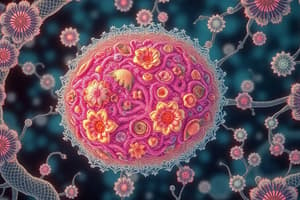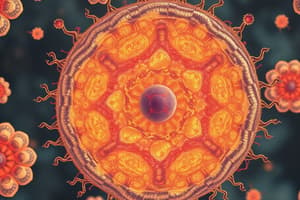Podcast
Questions and Answers
Which of the following cell types is characterized by the presence of a nucleus and organelles?
Which of the following cell types is characterized by the presence of a nucleus and organelles?
- Both prokaryotic and eukaryotic cells
- Eukaryotic cells (correct)
- Neither prokaryotic nor eukaryotic cells
- Prokaryotic cells
What is one major difference between prokaryotic and eukaryotic cells?
What is one major difference between prokaryotic and eukaryotic cells?
- Prokaryotic cells contain organelles
- Prokaryotic cells have a nucleus
- Eukaryotic cells reproduce only asexually
- Eukaryotic cells are larger than prokaryotic cells (correct)
Which of the following organisms is classified as a eukaryote?
Which of the following organisms is classified as a eukaryote?
- Fungi (correct)
- Viruses
- Bacteria
- Archaea
Which process is utilized by eukaryotic cells for reproduction?
Which process is utilized by eukaryotic cells for reproduction?
Which statement correctly describes the organization of prokaryotic cells?
Which statement correctly describes the organization of prokaryotic cells?
What is the primary outcome of mitosis?
What is the primary outcome of mitosis?
Which stage occurs first in the process of meiosis?
Which stage occurs first in the process of meiosis?
What distinguishes meiosis from mitosis?
What distinguishes meiosis from mitosis?
During which phase of meiosis does independent assortment occur?
During which phase of meiosis does independent assortment occur?
How many total cells are produced at the end of meiosis?
How many total cells are produced at the end of meiosis?
Which of the following statements about mitosis is incorrect?
Which of the following statements about mitosis is incorrect?
What is the significance of crossover recombination in meiosis?
What is the significance of crossover recombination in meiosis?
In terms of chromosome structure, eukaryotic cells have:
In terms of chromosome structure, eukaryotic cells have:
What is the primary host of Toxoplasma gondii?
What is the primary host of Toxoplasma gondii?
Which disease is primarily transmitted by the 'kissing bug'?
Which disease is primarily transmitted by the 'kissing bug'?
What is a common early symptom of Chagas disease?
What is a common early symptom of Chagas disease?
Which protozoan is associated with visceral leishmaniasis?
Which protozoan is associated with visceral leishmaniasis?
What mechanism does Trypanosoma brucei use to evade the immune system?
What mechanism does Trypanosoma brucei use to evade the immune system?
What is the vector for Leishmania tropica?
What is the vector for Leishmania tropica?
Which of the following symptoms is NOT associated with visceral leishmaniasis?
Which of the following symptoms is NOT associated with visceral leishmaniasis?
What complex effect can result from an untreated visceral leishmaniasis infection?
What complex effect can result from an untreated visceral leishmaniasis infection?
What process allows protozoa to exchange genetic material?
What process allows protozoa to exchange genetic material?
What type of locomotion do amebas primarily use?
What type of locomotion do amebas primarily use?
Which of the following pathogens is known to cause amebic dysentery?
Which of the following pathogens is known to cause amebic dysentery?
What is the role of the cyst in the lifecycle of pathogenic amebas?
What is the role of the cyst in the lifecycle of pathogenic amebas?
What distinguishes lobed amebas from filamentous amebas?
What distinguishes lobed amebas from filamentous amebas?
What disease can Naegleria fowleria cause?
What disease can Naegleria fowleria cause?
Which of the following best describes the transmission route of Entamoeba histolytica?
Which of the following best describes the transmission route of Entamoeba histolytica?
What type of environment is Naegleria fowleria primarily found in?
What type of environment is Naegleria fowleria primarily found in?
What polysaccharide found in kelp is known for its use as a thickener in foods?
What polysaccharide found in kelp is known for its use as a thickener in foods?
Which of the following is a characteristic feature of diatoms?
Which of the following is a characteristic feature of diatoms?
What consequence is associated with the toxic blooms of diatoms?
What consequence is associated with the toxic blooms of diatoms?
Which organism is considered a mixotroph?
Which organism is considered a mixotroph?
What is the dominant classification of 'Favolaschia calocera'?
What is the dominant classification of 'Favolaschia calocera'?
What natural product derives from fossilized diatom cell walls?
What natural product derives from fossilized diatom cell walls?
Which component indicates the pathogenic nature of certain diatoms?
Which component indicates the pathogenic nature of certain diatoms?
What type of organism is primarily responsible for the decline in marine protist biomass as sea temperatures rise?
What type of organism is primarily responsible for the decline in marine protist biomass as sea temperatures rise?
Flashcards are hidden until you start studying
Study Notes
Eukaryotes
- Two types of cells: eukaryotic and prokaryotic
- All living organisms are composed of either eukaryotic cells or prokaryotic cells
- Prokaryotic cells are smaller and simpler than eukaryotic cells
- Prokaryotic cells do not have a nucleus or organelles
- Eukaryotic cells are larger and more complex than prokaryotic cells
- Eukaryotic cells have a nucleus and organelles
- Prokaryotes reproduce asexually via binary fission
- Eukaryotes reproduce both asexually (mitosis) and sexually(meiosis)
- Prokaryotic cells are unicellular but Eukaryotic cells can be uni- or multicellular
Eukaryotic Cell Structure
- Nucleus: Contains the cell's genetic material (DNA) and controls cellular activities
- Mitochondria: Powerhouse of the cell, responsible for generating ATP through cellular respiration.
- Golgi Complex: Responsible for packaging and sorting proteins and lipids, and transporting them to other parts of the cell
- Rough Endoplasmic Reticulum (RER): Ribosomes are attached to the RER, it is the site of protein synthesis
- Chloroplast: Found in plant cells, responsible for photosynthesis
- Smooth Endoplasmic Reticulum (SER): Involved in lipid synthesis, detoxification, and calcium storage
- Lysosome: Contains hydrolytic enzymes for breaking down waste material and cellular debris
- Plasma Membrane: Regulates the movement of substances into and out of the cell, it is a selectively permeable membrane
- Flagella: Long, whip-like structures that help in cell motility
Eukaryotic Cell Division
- Mitosis: Asexual reproduction - produces two genetically identical daughter cells from one parent cell
- Meiosis: Produces four genetically unique daughter cells from one parent cell, each with half the number of chromosomes.
- Mitosis can occur in haploid or diploid cells
- Meiosis can only occur in diploid cells
Kingdoms and Domains
- Eukaryotic organisms are classified into four kingdoms: Protista, Fungi, Plantae, and Animalia
- Organisms are further classified into three domains: Bacteria, Archaea, and Eukarya
Protista
- Protists are a diverse group of eukaryotic organisms that are not animals, plants, or fungi
- Protozoa: Heterotrophic protists - include various groups like amoebas, alveolates, and apicomplexans
Amoeba
- Move using pseudopods (false feet)
- Two main types: lobed amoeba and filamentous amoeba
Pathogenic Amebas
- Entamoeba hystolytica: Cause amebic dysentery, transmitted through fecal-oral route
- Naegleria fowleria: Brain-eating amoeba, enters through the nasal cavity, crosses the blood-brain barrier, and causes amebic meningoencephalitis
- Acanthamoeba: Causes corneal infection, commonly associated with contaminated contact lenses
Apicomplexans
- Intracellular parasites
- Toxoplasma gondii: Can infect all nucleated cells, spread through cat feces, and potentially cause brain infections
- Trypanosoma cruzi: Causes Chagas disease, transmitted via kissing bugs
- Leishmania: Causes leishmaniasis, transmitted through sand flies, affecting skin and internal organs
Algae
- A diverse group of photosynthetic protists
- Some algae are very large, like the giant kelp
- Some algae are unicellular and many are edible
Fungi
- Multicellular organisms that produce fruiting bodies, called mushrooms
- Can be saprophytic, parasitic, or mutualistic
- Some fungi are unicellular, like yeast
- Fungi are heterotrophic and obtain nutrients by absorbing organic matter
Lichens and Mycorrhizae
- Lichens are a symbiotic relationship between a fungus and an alga
- Mycorrhizae are a symbiotic relationship between a fungus and a plant root
- Both lichens and mycorrhizae are important for nutrient cycling in the environment and ecosystem health
Diatoms
- Unicellular algae with silica cell walls
- Important primary producers in marine ecosystems
- The fossilized remains of diatoms make up diatomaceous earth, used as a pesticide
- Diatoms, alongside other algae, are capable of producing harmful algal blooms which can cause illness if consumed
Dinoflagellates
- Responsible for red tides, which can cause mass fish kills and shellfish poisoning
- Important primary producers in marine ecosystems
- Some dinoflagellates produce toxins that can bioaccumulate in shellfish, causing harm to humans if consumed
Importance of Protists and Fungi
- Protists and fungi play vital roles in ecosystems, including decomposing organic matter, producing oxygen, and serving as food sources for other organisms.
- Fungi are also important for food production, such as mushrooms and bread, and for medicine, such as antibiotics.
The future of protists and fungi
- Protist and fungal populations are threatened by various environmental factors like pollution, climate change, and habitat destruction, requiring sustainable solutions to protect their biodiversity.
Studying That Suits You
Use AI to generate personalized quizzes and flashcards to suit your learning preferences.




